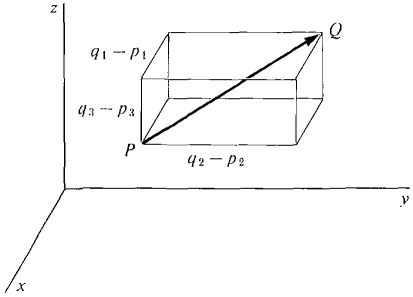| The ebook Elementary Calculus is based on material originally written by H.J. Keisler. For more information please read the copyright pages. |

|

Home  Vectors Vectors  Vectors and Lines in Space Vectors and Lines in Space  Points, Lines and Vectors Points, Lines and Vectors |
|






|
|
Points, Lines and Vectors
A point in space has three coordinates, one along each axis. We thus identify a point in space with an ordered triple of real numbers, as in Figure 10.3.2.
Figure 10.3.2 Given two points P(p1, p2, p3) and Q(q1, q2, q3) in space, the directed line segment PQ has the x-component q1 - p1, y-component q2 - p2, and z-component q3 - p3 (Figure 10.3.3).
Figure 10.3.3 A Directed Line Segment The family of all directed line segments in space which have the same three components as The examples of vectors which we discussed in the plane also arise naturally in space. In space, position, velocity, acceleration, force, and displacement are vector quantities with three dimensions. In an economic model with three commodities, the commodity and price vectors have three dimensions. Vectors in n dimensions arise quite naturally in economics, as commodity and price vectors in an economic model with n commodities. They also arise in more advanced parts of physics, such as quantum mechanics. Sums, negatives, differences, and scalar multiples of vectors in three dimensions are defined exactly as in two dimensions. The length, or norm, of a vector A with components a1 ,a2,a3 is defined by
|
|
Home  Vectors Vectors  Vectors and Lines in Space Vectors and Lines in Space  Points, Lines and Vectors Points, Lines and Vectors |
|
Last Update: 2006-11-21




 is called the
is called the  .
.